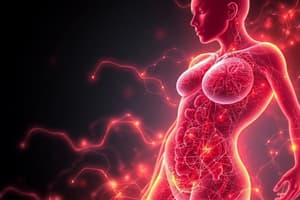Podcast
Questions and Answers
What is released during the process of lipolysis?
What is released during the process of lipolysis?
- Fatty acids and glucose
- Triacylglycerol only
- Only glycerol
- Three fatty acids and glycerol (correct)
Which hormone is NOT considered a lipolytic factor?
Which hormone is NOT considered a lipolytic factor?
- Glucagon
- ACTH
- Insulin (correct)
- Epinephrine
What enzyme is activated by 3',5'-cyclic AMP during lipolysis?
What enzyme is activated by 3',5'-cyclic AMP during lipolysis?
- Monoacylglycerol lipase
- Hormone sensitive lipase (HSL) (correct)
- Phosphodiesterase
- Triacylglycerol lipase
What effect does insulin have on lipolysis?
What effect does insulin have on lipolysis?
Which of the following conditions is likely to result in excessive lipolysis?
Which of the following conditions is likely to result in excessive lipolysis?
What role does adenylyl cyclase play in lipolysis regulation?
What role does adenylyl cyclase play in lipolysis regulation?
Which of the following substances acts to inhibit phosphodiesterase, thereby affecting lipolysis?
Which of the following substances acts to inhibit phosphodiesterase, thereby affecting lipolysis?
What is the primary end product of the lipolytic process?
What is the primary end product of the lipolytic process?
What is the primary function of carnitine acyl transferase I?
What is the primary function of carnitine acyl transferase I?
Which plant-based food is noted for being a source of carnitine?
Which plant-based food is noted for being a source of carnitine?
What is the initial step in the breakdown of fatty acids during beta-oxidation?
What is the initial step in the breakdown of fatty acids during beta-oxidation?
What is the importance of β-oxidation in metabolism?
What is the importance of β-oxidation in metabolism?
Which of the following organs does NOT perform fatty acid beta-oxidation?
Which of the following organs does NOT perform fatty acid beta-oxidation?
What effect does increased ATP concentration have on β-oxidation?
What effect does increased ATP concentration have on β-oxidation?
What is the primary function of carnitine in fatty acid metabolism?
What is the primary function of carnitine in fatty acid metabolism?
What is the net energy gain from the oxidation of palmitic acid?
What is the net energy gain from the oxidation of palmitic acid?
Which step in beta-oxidation follows hydration?
Which step in beta-oxidation follows hydration?
Which component of carnitine metabolism is regulated indirectly through malonyl CoA?
Which component of carnitine metabolism is regulated indirectly through malonyl CoA?
Which energy source provides the most kcal per gram?
Which energy source provides the most kcal per gram?
What condition may occur due to a deficiency in carnitine?
What condition may occur due to a deficiency in carnitine?
From which two amino acids is carnitine synthesized in the body?
From which two amino acids is carnitine synthesized in the body?
What occurs during the thiolase reaction in fatty acid beta-oxidation?
What occurs during the thiolase reaction in fatty acid beta-oxidation?
Which statement about beta-oxidation is true?
Which statement about beta-oxidation is true?
Which organ systems are affected by genetic CPT deficiency?
Which organ systems are affected by genetic CPT deficiency?
What is one potential result of a carnitine deficiency?
What is one potential result of a carnitine deficiency?
How are odd-numbered fatty acids oxidized?
How are odd-numbered fatty acids oxidized?
What is the fate of succinyl CoA?
What is the fate of succinyl CoA?
What characterizes phytanic acid with regard to β-oxidation?
What characterizes phytanic acid with regard to β-oxidation?
Where does α-oxidation predominantly occur?
Where does α-oxidation predominantly occur?
What is a symptom associated with Refsum's disease?
What is a symptom associated with Refsum's disease?
What is removed during α-oxidation?
What is removed during α-oxidation?
Flashcards
Lipolysis
Lipolysis
The process of breaking down triglycerides (TAGs) into their building blocks: three fatty acids and glycerol. This releases stored fat for energy.
Lipase enzymes for lipolysis
Lipase enzymes for lipolysis
Enzymes that carry out lipolysis, breaking down triglycerides in adipose tissue.
Cyclic AMP (cAMP)
Cyclic AMP (cAMP)
The molecule that activates lipase enzymes, triggering the breakdown of triglycerides.
Lipolytic hormones
Lipolytic hormones
Signup and view all the flashcards
Anti-lipolytic hormone
Anti-lipolytic hormone
Signup and view all the flashcards
Fatty acid oxidation
Fatty acid oxidation
Signup and view all the flashcards
Beta-oxidation
Beta-oxidation
Signup and view all the flashcards
Causes of excessive lipolysis
Causes of excessive lipolysis
Signup and view all the flashcards
Steps in Beta Oxidation
Steps in Beta Oxidation
Signup and view all the flashcards
Fatty Acid Activation
Fatty Acid Activation
Signup and view all the flashcards
Carnitine Shuttle
Carnitine Shuttle
Signup and view all the flashcards
What is Carnitine?
What is Carnitine?
Signup and view all the flashcards
Importance of Fatty Acid Oxidation
Importance of Fatty Acid Oxidation
Signup and view all the flashcards
Carnitine
Carnitine
Signup and view all the flashcards
Carnitine Acyltransferase I (CAT I)
Carnitine Acyltransferase I (CAT I)
Signup and view all the flashcards
Carnitine Acyltransferase II (CAT II)
Carnitine Acyltransferase II (CAT II)
Signup and view all the flashcards
β-Oxidation
β-Oxidation
Signup and view all the flashcards
Acetyl CoA
Acetyl CoA
Signup and view all the flashcards
Ketone Bodies
Ketone Bodies
Signup and view all the flashcards
Carnitine Deficiency
Carnitine Deficiency
Signup and view all the flashcards
β-Oxidation Cycles
β-Oxidation Cycles
Signup and view all the flashcards
Genetic CPT- deficiency
Genetic CPT- deficiency
Signup and view all the flashcards
Fasting hypoglycemia and muscle weakness
Fasting hypoglycemia and muscle weakness
Signup and view all the flashcards
Oxidation of odd-numbered fatty acids
Oxidation of odd-numbered fatty acids
Signup and view all the flashcards
Propionyl CoA metabolism
Propionyl CoA metabolism
Signup and view all the flashcards
Phytanic acid
Phytanic acid
Signup and view all the flashcards
Alpha-oxidation
Alpha-oxidation
Signup and view all the flashcards
Refsum’s disease
Refsum’s disease
Signup and view all the flashcards
Study Notes
Lipid Metabolism: Lipolysis and Fatty Acid β-Oxidation
- Lipolysis is the hydrolytic release of fatty acids and glycerol from TAGs. This process mobilizes stored fat.
- Lipolysis is carried out by three enzymes in adipose tissue: triacylglycerol lipase, hormone-sensitive diacylglycerol lipase (HSL), and monoacylglycerol lipase.
- Lipolysis is regulated by hormones like epinephrine and glucagon, leading to the production of cyclic AMP. This activates a protein kinase, which then phosphorylates and activates lipases.
- Insulin inhibits lipolysis, while hormones like epinephrine, glucagon, and growth hormone stimulate it.
- Regulation of lipolysis is essential for energy production in situations like starvation or insufficient glucose intake.
Steps in Lipolysis
- Lipolysis is a sequential process of hydrolysis of TAGs in adipocytes and lipid droplets.
- Enzymes progressively remove fatty acids from TAGs resulting in free fatty acids and glycerol.
Regulation of Lipolysis
- Cyclic AMP production in adipocytes is critical for lipolysis. Hormones (epinephrine, glucagon) trigger this production.
- The subsequent activation of adenylate cyclase leads to the activation of a protein kinase, which activates lipases, thus promoting the release of fatty acids from TAGs.
Fatty Acid Oxidation (β-Oxidation)
- Lipids, particularly fatty acids, provide significant energy, undergoing oxidation in three main pathways: α, β, and ω.
- Fatty acid oxidation, specifically β-oxidation, involves enzymes in the mitochondria.
- β-oxidation sequentially cleaves two-carbon units from fatty acids, forming acetyl-CoA.
- The acetyl-CoA enters the citric acid cycle for further energy production.
- The β-oxidation process occurs in mitochondria of liver, kidney, heart, and skeletal muscles. It does not occur in erythrocytes or brain tissues due to the absence of mitochondria in erythrocytes or impermeable blood-brain barrier.
Steps in Beta Oxidation
- Fatty acid activation in the cytoplasm by esterification with CoASH.
- Transport of fatty acyl CoA esters across the mitochondrial membrane.
- A sequential series of reactions known as the carbon backbone reaction sequence of: dehydrogenation, hydration, and subsequent dehydrogenation and cleavage (thiolase reaction) happens within the mitochondrial matrix.
Carnitine Shuttle
- Carnitine is essential for transporting long-chain acyl CoA from the cytosol to the mitochondria.
- The carnitine shuttle is a 3-step process mediated by carnitine acyltransferases (I and II) and a translocase.
- The shuttle delivers fatty acyl groups to the appropriate cellular location inside the mitochondria
Carnitine Structure and Sources
- Carnitine is a compound synthesized from amino acids lysine and methionine primarily in the liver and kidneys (but not in skeletal or heart muscle).
- Dietary sources of carnitine include meat products.
Oxidation of Odd-Number Fatty Acids
- Odd-numbered fatty acids undergo the same β-oxidation steps as even-numbered fatty acids until the final three carbons are reached.
- The three-carbon compound (propionyl CoA) requires a specialized three-step pathway for metabolism.
- The final product of this metabolism is succinyl CoA, a valuable intermediate in various metabolic pathways.
Sources and Fate of Succinyl CoA
- Succinyl CoA arises from the oxidation of odd-numbered fatty acids, as well as from the catabolism of various amino acids (e.g., valine, leucine, isoleucine).
- Succinyl CoA plays a critical role in the citric acid cycle, glucose formation, heme synthesis, oxidation in the citric acid cycle, activation of ketone bodies, and detoxification.
α-Oxidation of Fatty Acids
- α-oxidation is a specific pathway that occurs primarily in the brain and nervous tissues.
- It removes one carbon atom at a time from the α-position of branched fatty acids.
- This process does not require coenzyme A and doesn't produce high-energy phosphate compounds.
- A key example of the importance of this pathway is the metabolism of phytanic acid. Phytanic acid is a branched fatty acid and its metabolism via α-oxidation in brain and nervous tissue is critical.
Refsum Disease
- Refsum disease is a genetic disorder affecting the brain and nervous tissues.
- It arises from a defect in a-oxidation, creating phytanic acid accumulation in the body.
- Symptoms include nervous system dysfunction.
Differences between α and β oxidation
- β-oxidation occurs in the liver and requires CoA.
- α-oxidation occurs in brain and does not require CoA.
- β-oxidation removes 2 carbons per cycle and generates energy, while α-oxidation removes 1 carbon per cycle and doesn't generate energy.
Studying That Suits You
Use AI to generate personalized quizzes and flashcards to suit your learning preferences.



